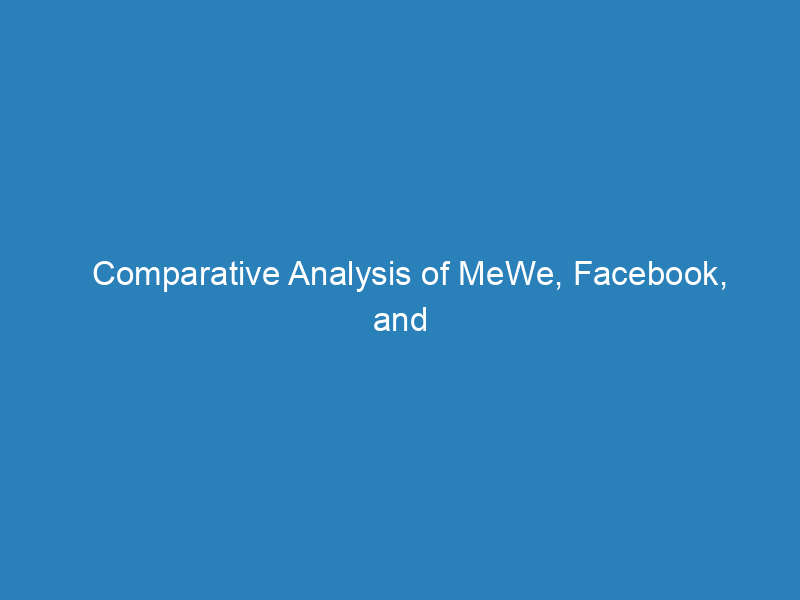
Comparative Analysis of MeWe, Facebook, and Twitter: Features, Privacy, and User Experience
Social networking has become a cornerstone of modern life, enabling us to connect with loved ones, share experiences, and stay updated on current events. With a myriad of platforms available, each offering distinct features, users now have more choices than ever. While giants like Facebook and Twitter dominate the landscape, emerging platforms such as MeWe cater specifically to those who prioritize privacy. In this article, we will delve into the unique attributes of MeWe, Facebook, and Twitter, highlighting how MeWe stands out as a viable option for privacy-conscious users.
Understanding MeWe
Launched in 2016, MeWe positions itself as a secure and private social networking platform. Its user-friendly design allows for easy account creation, but what truly sets it apart are its core features. MeWe offers private and group chats, status updates, and an integrated marketplace—all without the interference of ads. Importantly, the platform is committed to user privacy, refraining from collecting personal data or facilitating online surveillance. With end-to-end encryption for private messages, MeWe ensures that conversations remain entirely confidential, inaccessible to both advertisers and government entities.
MeWe is particularly appealing to younger demographics who value online security, making it an attractive alternative to Facebook and Twitter. While it operates on a freemium model—allowing users to explore premium features for 30 days before transitioning to a subscription of $4.99 per month—its growth trajectory reflects a strong demand for privacy-focused social networks free from invasive advertising.
Facebook: The Social Media Giant
Facebook reigns as the largest social networking platform globally, boasting over 2.96 billion monthly active users as of 2022. Established in 2004, Facebook has developed an extensive suite of features, including status updates, photo and video sharing, and marketplace functionalities. Its diverse user base encompasses individuals, businesses, and organizations alike.
However, Facebook has not been without controversy. The platform has faced significant criticism regarding privacy and security, particularly concerning its data collection practices and the targeted advertising that follows. Additionally, it has grappled with the spread of misinformation and political propaganda, raising concerns about its influence and responsibility in public discourse.
Twitter: The Real-Time Update Hub
Founded in 2006, Twitter—now rebranded as X—has carved its niche as a microblogging service, allowing users to share quick updates in 280-character snippets. With approximately 450 million monthly active users in 2022, Twitter serves as a key platform for public conversations and real-time news sharing, making it a favorite among journalists, celebrities, and politicians.
While Twitter excels in facilitating immediate communication and trending topics, it has also faced scrutiny over misinformation and its moderation policies, particularly following changes in ownership. Its user experience can be marred by issues such as trolling and harassment, which detract from its reputation as a safe space for dialogue.
Feature Comparison: MeWe, Facebook, and Twitter
When assessing the features of these three platforms, a clear distinction emerges:
MeWe
- Privacy-Focused: MeWe promotes secure communication through end-to-end encryption and does not monetize user data.
- Ad-Free Experience: Users enjoy a clean interface without the distractions of advertisements.
- Customizable Profiles: MeWe allows users to personalize their profiles and join interest-based groups, fostering community connections.
- Extensive Features: Facebook offers a wide array of functionalities, including groups, events, and a comprehensive news feed.
- Large User Base: Its vast audience facilitates connections across a variety of interests.
- Integration: Facebook easily connects with other apps and websites, enhancing user convenience.
- Real-Time News: Twitter excels at providing immediate updates, making it a go-to for breaking news.
- Public Engagement: The platform fosters discussions on trending topics through its hashtag system.
- Diverse User Base: With a wide range of users, it serves as a hub for various interests and conversations.
Evaluating the Pros and Cons
Each platform comes with its own advantages and challenges:
MeWe
- Pros:
- Strong focus on user privacy.
- No advertisements for a streamlined experience.
- Enhanced security with end-to-end encryption.
- Allows for personalized profiles and interest-based interactions.
- Cons:
- Smaller user base compared to Facebook and Twitter.
- Limited reach and content availability.
- Less brand recognition as a newer platform.
- Pros:
- Massive user base for easy connections.
- Comprehensive feature set for diverse interactions.
- Broad reach for personal and business communications.
- Cons:
- Ongoing privacy concerns regarding data use.
- Advertisements can disrupt user experience.
- Algorithm-driven news feed may obscure important updates.
- Pros:
- Excellent for real-time updates and news.
- Wide reach allows for diverse engagement.
- Facilitates public discourse on numerous issues.
- Cons:
- Character limit restricts detailed expression.
- High rates of trolling and online harassment.
- Algorithmic timeline may lead to missed content.
In summary, each platform offers unique advantages and drawbacks, catering to varying user needs and preferences. MeWe shines in its commitment to privacy, while Facebook and Twitter deliver extensive features and engagement opportunities, albeit with associated concerns about user data and security. As the landscape of social networking continues to evolve, users must carefully consider which platform aligns best with their values and communication goals.

